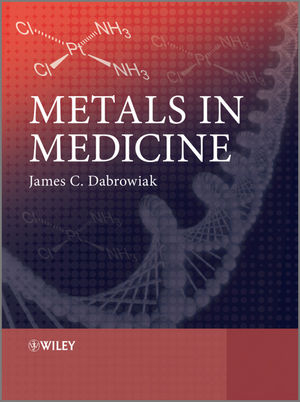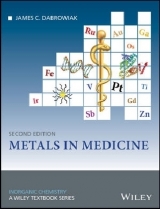
Metals in Medicine
Wiley-Blackwell (Verlag)
978-0-470-68196-1 (ISBN)
- Titel ist leider vergriffen;
keine Neuauflage - Artikel merken
Working from basic chemical principles, Metals in Medicine presents a complete and methodical approach to the topic. Introductory chapters discuss important bonding concepts applicable to metallo-drugs and their biological targets, interactions that exist between the agents and substances in the biological milieu, basic pharmacokinetic and pharmacodynamic properties including transport and uptake of drugs by the cells, and methods for measuring efficacy and toxicity of agents. The steps from drug discovery to market place are also briefly outlined and discussed. These chapters lay the groundwork, in order that students can clearly understand how agents work, whatever their subject background. Following this introduction, chapters focus on individual metallo-drugs and agents for treating and detecting disease, their synthesis, structure and general properties, known mechanism of action and important physical and chemical principles that apply.
Topics covered include cisplatin; platinum anticancer drugs; ruthenium, titanium, and gallium for treating cancer; gold compounds for treating arthritis, cancer, and other diseases; vanadium, copper, and zinc in medicine; metal complexes for diagnosing disease; and metals in nanomedicine. Throughout the book, "Feature Boxes" expand on features of drugs that are not directly related to studying metals in medicine, for example discovery, medical use, specialist assays, and metals in biology. At the end of the chapters there are specifically designed problems/exercises that apply basic kinetic, thermodynamic and chemical principles to practical problem solving in metals in medicine. Metals in Medicine distils the essence of this important topic for undergraduate and graduate students in chemistry, biochemistry, biology and the related areas of biophysics, pharmacology, and bioengineering, and for researchers in other fields interested in getting a general insight into metals in medicine.
Feature Boxes. Preface. Acknowledgments. 1 Inorganic Chemistry Basics. 1.1 Crystal field theory. 1.2 Molecular orbital theory. 1.3 Absorption spectra of metal complexes. 1.4 Magnetic properties of metal complexes. 1.5 Reactions of metal complexes. Problems. References. Further reading. 2 Metallo-Drugs and Their Action. 2.1 Introduction. 2.2 Proteins as targets for metallo-drugs. 2.3 DNA as a target for metallo-drugs. 2.4 Reaction of metal complexes in the biological milieu. 2.5 Evaluating the pharmacological effects of agents. 2.6 From discovery to the marketplace. Problems. References. Further reading. 3 Cisplatin. 3.1 Physical and chemical properties of cisplatin. 3.2 Formulation, administration and pharmacokinetics. 3.3 Reaction of cisplatin in biological media. 3.4 Uptake, cytotoxicity and resistance. 3.5 Interaction of cisplatin with cellular targets. Problems. References. Further reading. 4 Platinum Anticancer Drugs. 4.1 Carboplatin. 4.2 Oxaliplatin. 4.3 New platinum agents. Problems. References. Further reading. 5 Ruthenium, Titanium and Gallium for Treating Cancer. 5.1 Ruthenium compounds for treating cancer. 5.2 Titanium compounds for treating cancer. 5.3 Gallium for treating cancer. Problems. References. Further reading. 6 Gold Compounds for Treating Arthritis, Cancer and Other Diseases. 6.1 Chemistry of gold in biological media. 6.2 Gold compounds for treating arthritis. 6.3 Gold complexes for treating cancer. 6.4 Gold complexes for treating AIDS and other diseases. Problems. References. Further reading. 7 Vanadium, Copper and Zinc in Medicine. 7.1 Vanadium for treating diabetes. 7.2 Role of copper and other metal ions in Alzheimer's disease. 7.3 Copper in Wilson's and Menkes diseases. 7.4 Zinc-bicyclam: a chemokine receptor antagonist. Problems. References. Further reading. 8 Metal Complexes for Diagnosing Disease. 8.1 Technetium in diagnostic nuclear medicine. 8.2 Metal compounds as contrast agents for MRI. 8.3 Radionuclides for palliative care and cancer treatment. Problems. References. Further reading. 9 Nanomedicine. 9.1 Nanoscience for treating disease. 9.2 Nanomedicine in diagnosing disease. 9.3 Potential health risks of nanoparticles. Problems. References. Further reading. Index.
| Erscheint lt. Verlag | 1.1.2010 |
|---|---|
| Zusatzinfo | Illustrations |
| Verlagsort | Hoboken |
| Sprache | englisch |
| Maße | 197 x 255 mm |
| Gewicht | 812 g |
| Themenwelt | Medizin / Pharmazie ► Medizinische Fachgebiete ► Pharmakologie / Pharmakotherapie |
| Naturwissenschaften ► Chemie ► Anorganische Chemie | |
| Naturwissenschaften ► Chemie ► Organische Chemie | |
| ISBN-10 | 0-470-68196-9 / 0470681969 |
| ISBN-13 | 978-0-470-68196-1 / 9780470681961 |
| Zustand | Neuware |
| Informationen gemäß Produktsicherheitsverordnung (GPSR) | |
| Haben Sie eine Frage zum Produkt? |
aus dem Bereich



